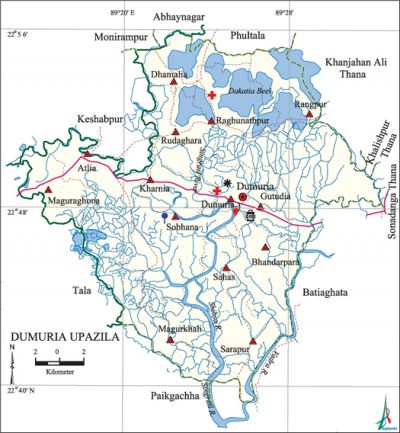Dumuria Upazila
Dumuria Upazila (khulna district) area 454.23 sq km, located in between 22°39' and 22°56' north latitudes and in between 89°15' and 89°32' east longitudes. It is bounded by manirampur, abhaynagar and phultala upazilas on the north, batiaghata and paikgachha upazilas on the south, khan jahan ali, khalishpur and sonadanga thanas and Batiaghata upazila on the east, tala and keshabpur upazilas on the west.
Population Total 279862; male 144334, female 135528; Muslim 164126, Hindu 115245, Buddhist 264 and others 225.
Water bodies Main rivers: Shibsa and Singrail; beel dakatia is notable.
Administration Dumuria Thana was formed on 25 March, 1918 and it was turned into an upazila in 1983.
| Upazila | ||||||||
| Municipality | Union | Mouza | Village | Population | Density (per sq km) | Literacy rate (%) | ||
| Urban | Rural | Urban | Rural | |||||
|
- |
14 |
203 |
237 |
16924 |
262938 |
616 |
49.05 |
48.64 |
| Upazila Town | ||||||||
|
Area |
Mouza |
Population |
Density |
Literacy rate | ||||
|
6.93 |
4 |
16924 |
2442 |
49.05 | ||||
| Union | ||||
| Name of union and GO code | Area (acre) | Population | Literacy rate (%) | |
| Male | Female | |||
|
Atlia 06 |
10219 |
15155 |
13841 |
48.70 |
|
Kharnia 40 |
5160 |
9615 |
8858 |
46.41 |
|
Gutudia 33 |
14118 |
11351 |
10477 |
48.92 |
|
Dumuria 27 |
4625 |
12942 |
11763 |
49.73 |
|
Dhamalia 20 |
5754 |
10499 |
10037 |
45.82 |
|
Bhandar Para 13 |
8726 |
8083 |
7817 |
50.14 |
|
Magurkhali 47 |
9909 |
8026 |
7294 |
55.20 |
|
Maguraghona 54 |
4891 |
10861 |
10193 |
41.07 |
|
Rangpur 67 |
8960 |
8149 |
7770 |
48.50 |
|
Raghunathpur 61 |
8764 |
11875 |
11453 |
54.10 |
|
Rudaghara 74 |
7100 |
11079 |
10388 |
49.14 |
|
Sarappur 88 |
5714 |
8014 |
7682 |
49.99 |
|
Sobhana 94 |
10972 |
9904 |
9465 |
51.12 |
|
Sahas 81 |
6173 |
8781 |
8490 |
42.34 |
Source Bangladesh Population Census 2001,Bangladesh Bureau of Statistics.

Archaeological heritage and relics Chechuri Neel Kuthi, Chuknagar Neel Kuthi, Dakbangalow at Madhugram.
Historical events tebhaga movement was organised in 1948 at villages Shovana, Dhanibunia, Kanaidanga, Orabunia and Bakultala. During the war of liberation, the Pakistan army raided the village Kalitalapara in April 1971 and many Bangalis including Profullo Kumar Biswas, Indubhushan, Lalchand, Amullya, Mahendra, Raicharan, Nihar and Ratan were killed. Fourteen members of the allied forces were killed in a direct encounter with the Pak army at Shalua Bazar. In the early months of the War of Liberation, Chuknagar formed a transit point for Bangali refugees, fleeing to India in the face of atrocities ofthe Pakistan army. On 20 May 1971, the Pakistan army killed thousands of refugees assembled at the village. Every year the day is mourned as the Chuknagar Mass Killing Day.
Religious institutions Mosque 237, temple 132, church 4. Noted religious institutions: Arashnagar Mosque, Dumuria Kali Mandir, Delbhita Durga Mandir, Taltala Math, Prahlad Ashrama.
Literacy rate and educational institutions Average literacy 48.66%; male 55.04%, female 41.91%. Educational institutions: college 8, secondary school 50, primary school 199, madrasa 28. Noted educational institutions: Shahpur Madhugram College (1969), Anukul Chandra Sanskrit College (1976), Dumuria College (1983), Raghunathpur Secondary School (1880), Madhugram Senior Madrasa (1928).
Newspapers and periodicals Purushottamduti, Padatik, Sabuj Patra (1965), Sangbartak (1971), Shatabdir Dak (1972),
Main sources of income Agriculture 65.43%, non-agricultural labourer 3.08%, commerce 14.05%, transport and communication 5.51%, service 5.54%, construction 0.88%, religious service 0.16%, rent and remittance 0.10% and others 5.25%.
Ownership of agricultural land Landowner 69.36%, landless 30.64%. Agricultural landowner: urban 42.14% and rural 71%.'
Main crops Paddy, jute, vegetables.
Extinct or nearly extinct crops Sesame.
Main fruits Mango, jackfruit, coconut, betel nut.
Fisheries, dairies, poultries Hatchery 5, fishery 15100, poultry 255, dairy 89.
Extinct or nearly extinct traditional transport Palanquin, horse carriage, bullock cart.
Noted manufactories Rice mill, flour mill, oil mill, pulse mill, ice factory, bidi factory.
Cottage industries Goldsmith, weaving, potteries, blacksmith, bamboo work, wood work.
Hats, bazars and fairs Dumuria, Shahpur, Chuknagar, Kharnia, Atharomile and Madartala Hats;' Baishakhi, Chaitra Samkranti' and Balaisadur Melas are notable.
Main exports Paddy, rice, betel nut, molasses, prawn, mango, jackfruit, vegetables.
Access to electricity All the unions of the upazila are under rural electrification net-work. However 21.98% of the dwelling households have access to electricity.
Sources of drinking water Tube-well 97.19%, pond 0.69%, tap 1.20% and others 0.92%.
Sanitation 50.61% (urban 31.69% and rural 51.75%) of dwelling households of the upazila use sanitary latrines and 35.54% (urban 58.40% and rural 34.16%) of dwelling households use non-sanitary latrines; 13.86% of households do not have latrine facilities
Health centres Upazila health complex, hospital, clinic, health and family welfare centre.
NGO activities Operationally important NGOs are brac, Prodipan, asa, proshika, NIJERA KARI, caritas, CSS, CARE, Progoti. [Sandipak Mallik]
References Bangladesh Population Census 2001, Bangladesh Bureau of Statistics; Cultural survey report of Dumuria Upazila 2007.
